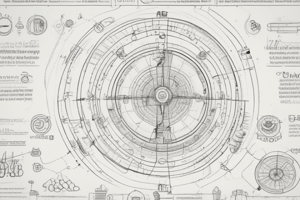Podcast
Questions and Answers
What is the main advantage of field studies in data collection?
What is the main advantage of field studies in data collection?
- It relies solely on theoretical data.
- It eliminates the need for primary data.
- It reflects real-world scenarios. (correct)
- It guarantees a controlled environment.
In a likely experiment, which variable is considered the independent variable?
In a likely experiment, which variable is considered the independent variable?
- The variable that is measured.
- The variable that is manipulated. (correct)
- The variable that is observed.
- The variable that is controlled.
What type of data does the online data collection method typically involve?
What type of data does the online data collection method typically involve?
- Quantitative contact data.
- Only qualitative analysis results.
- Processed original data.
- Secondary data from existing sources. (correct)
Which of the following best describes between-subjects designs in experiments?
Which of the following best describes between-subjects designs in experiments?
What is a notable disadvantage of experiments compared to observational methods?
What is a notable disadvantage of experiments compared to observational methods?
Which of these options is used in within-subjects designs?
Which of these options is used in within-subjects designs?
What role does the moderating variable play in an experiment?
What role does the moderating variable play in an experiment?
What does measuring an independent variable in an experiment primarily aim to establish?
What does measuring an independent variable in an experiment primarily aim to establish?
What is social desirability bias?
What is social desirability bias?
Which question type allows respondents to answer in their own words?
Which question type allows respondents to answer in their own words?
What characterizes a dichotomous question?
What characterizes a dichotomous question?
Which of the following is an example of a multichotomous question?
Which of the following is an example of a multichotomous question?
Which of the following responses is an example of a Likert-type scale?
Which of the following responses is an example of a Likert-type scale?
What is the first step in the decision-making process?
What is the first step in the decision-making process?
Which question type is particularly useful in regression analysis?
Which question type is particularly useful in regression analysis?
Which type of question restricts respondents to a fixed set of responses?
Which type of question restricts respondents to a fixed set of responses?
Which of the following describes primary data collection?
Which of the following describes primary data collection?
What is the first step in designing a questionnaire?
What is the first step in designing a questionnaire?
What is a common application for using scales in surveys?
What is a common application for using scales in surveys?
Which method is not considered a primary data collection method?
Which method is not considered a primary data collection method?
What should follow the summarization of available data?
What should follow the summarization of available data?
Which variable is typically treated as the outcome in a questionnaire model?
Which variable is typically treated as the outcome in a questionnaire model?
What is the purpose of using existing questions or scales from literature?
What is the purpose of using existing questions or scales from literature?
What type of data is characterized as processed and interpreted by others?
What type of data is characterized as processed and interpreted by others?
What should be assessed about respondents when asking questions?
What should be assessed about respondents when asking questions?
Which of the following steps is focused on assessing the possibility of making an incorrect decision?
Which of the following steps is focused on assessing the possibility of making an incorrect decision?
How should additional information be collected if deemed necessary?
How should additional information be collected if deemed necessary?
In question modeling, which variable is used to explain the relationship between independent and dependent variables?
In question modeling, which variable is used to explain the relationship between independent and dependent variables?
What aspect of questions should be clearly defined based on the model?
What aspect of questions should be clearly defined based on the model?
What is the primary purpose of summarizing available data?
What is the primary purpose of summarizing available data?
Which of the following does NOT play a role in the administration of a questionnaire?
Which of the following does NOT play a role in the administration of a questionnaire?
What is an essential question to consider when formulating survey questions?
What is an essential question to consider when formulating survey questions?
What is considered essential for ensuring the acceptance of a questionnaire?
What is considered essential for ensuring the acceptance of a questionnaire?
What is the primary purpose of pretesting a questionnaire?
What is the primary purpose of pretesting a questionnaire?
Which aspect does NOT contribute to a good questionnaire design?
Which aspect does NOT contribute to a good questionnaire design?
What common misconception exists regarding sample size?
What common misconception exists regarding sample size?
What defines a probability sample?
What defines a probability sample?
What should be done with questions that do not provide adequate information during the revision stage?
What should be done with questions that do not provide adequate information during the revision stage?
What is a key factor in the introduction of a questionnaire?
What is a key factor in the introduction of a questionnaire?
How can personal interviews be utilized during pretesting?
How can personal interviews be utilized during pretesting?
Flashcards are hidden until you start studying
Study Notes
Designing A Questionnaire Steps
- Step 1: Information
- Determine what information to collect based on research hypotheses.
- Define the questions the survey aims to answer.
- Identify independent, dependent, moderating, and mediating variables in the study.
- Step 2: Administration
- Choose the method for administering the questionnaire.
- Step 3: Content
- Ensure each question is necessary and contributes to the research objectives.
- Consider using pre-existing questions or scales from literature.
- Step 4: Design
- Craft a questionnaire that looks professional and reflects the study's importance.
- Include a clear and convincing introduction to encourage respondents to cooperate.
- Aim for a concise questionnaire.
- Step 5: Pretest
- Revise each question to avoid ambiguity, confusion, offensiveness, or leading.
- Seek peer evaluations for feedback.
- Conduct personal interviews with respondents similar to the target population.
Sampling And Biases
- Population: Represents the entire group of interest in the study.
- Sample: A smaller, representative portion of the population selected for research.
- Probability Samples: Every member of the population has an equal chance of being chosen.
- Sample Size: The number of individuals included in the sample, regardless of the size of the population.
Methods of Data Collection
- Primary Data Collection: Focuses on gathering firsthand, original information directly from the source.
- Field Studies: Used for understanding real-world situations and exploring relationships between variables.
- Experiments: Conducted to establish causality and control specific variables.
- Online Data: Collected through surveys, questionnaires, or other online tools.
- Secondary Data Collection: Involves analyzing existing data obtained from various sources.
- Internal Sources: Documents, reports, and information available within the organization.
- External Sources: External publications, reports, articles, and databases.
- Between-Subjects Design: Compares two distinct groups of participants that receive different treatments.
- Within-Subjects Design: Tests the same group of participants under different conditions.
Studying That Suits You
Use AI to generate personalized quizzes and flashcards to suit your learning preferences.




